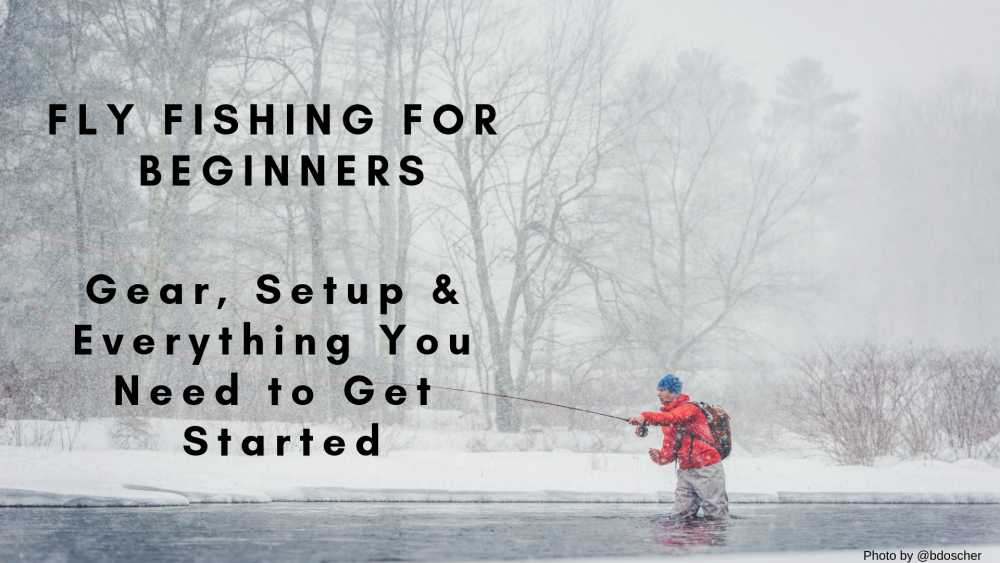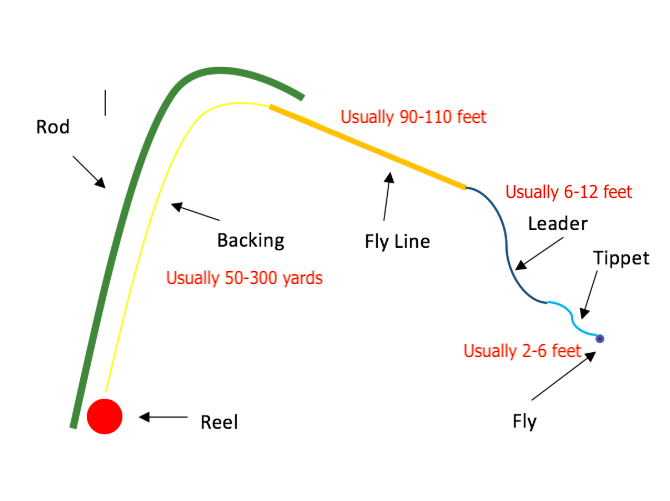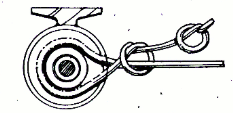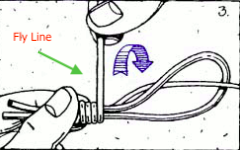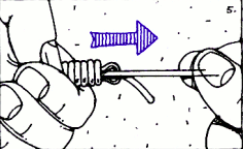Fly fishing is a beautiful sport that can take you into some of the most gorgeous natural environments in the world. If you are new to fly fishing, there is a lot to learn, but the journey is worthwhile. This article aims to help you understand the basics around a fly fishing rod setup.
In this article, we break down everything you need to know, plus link out to our other articles diving into deeper topics about gear, casting, the history of fly fishing, insect entomology, and more.
What Is Fly Fishing?
Fly fishing is a method of fishing that utilizes a fly rod, fly line, fly reel, and artificial flies (lures) to fish. Fly fishing utilizes various gear, casting methods, and can target just about any species of fish that other anglers can target. This sport has a long history from various cultures across the world.
Read more about fly fishing, fly casting, the differences between fly fishing and spin fishing, and casting information here.
Fly Rod Setup Diagram
To better understand a fly rod setup, you should watch this brief video:
Fly Rods
Fly rods come in various lengths, weights, and types that help anglers be as effective as possible in different environments. The type of fishing that an angler is looking for, will determine the type of fly rod that will be best. As the foundation for your fly fishing setup, the rod you are using determines what the angler will need for a reel and fly line. We also recommend after reading this article, you take a look at our picks for the best beginner fly rod and reel combos to help get you on the water with the right gear. You may want to read our up to date guide on the best 5 weight fly rods on the market as well.
Weight
The weight (wt) of a fly rod relates to the weight of the fly line that it is best suited for. Generally, a fly rod can handle fly line that is 1 weight above or below the weight of the fly line, but of course, a rod is balanced best for a fly line that matches the same weight as the fly rod. General Chart for Targeted Species & Weights to Use 1-4: sunfish and small trout, small streams 4-6: general trout, larger streams and rivers 6-8: bass, carp, light steelhead, salmon. and saltwater 8-10: winter steelhead, salmon, and saltwater 10-14: anything larger than steelhead, salmon, and smaller saltwater fish Beginner Tip: a 5 to 6-weight rod is probably the most versatile and allows you to have fun catching small fish, but still be versatile to go after some larger species.
Length
A fly rod is really just a large lever used for casting. The length plays a major roll in your casting abilities. The longer your lever (the longer your rod), the easier it is to cast longer distances. Longer rods also allow anglers to easily mend their line (adjust how it is floating on top of the water), and easily reach a rod over nice holes to help land more fish. The only downside to long rods are the maneuverability. In small streams or areas where there are overhanging brush, short rods enable anglers to fit into smaller areas. A 9 foot rod tends to be the most versatile setup for most situations. 9 feet gives anglers the ability to cast long distances, but also gives just enough maneuverability for most fishing situations. It is common to see rods from 10-14 feet for spey rods where casting long distances is essential.
Types of Rods
Single Handed Rod
Single handed rods are the most common rods that are designed for anglers to cast (surprisingly) with a single hand. They range in all types of weights, and range from 6 to 10 feet in length. These rods allow for the lightest presentations, and the most accurate casting. For handling very long casts, larger fish, or rivers where back casting isn’t possible, anglers often choose spey and switch rods (below).
Spey Rods
Spey rods are usually 12-14 feet in length, are used more frequently for “spey” casting (loading the rod with the line on the water, and not in a back cast), and handle heavier lines, bigger flies, and bigger fish. Spey rods are the most efficient at casting long distances, and allow fisherman to cast distance without a back cast, meaning they can have brush tightly behind them and still cast across a river. You’ll see them frequently with steelhead fishing. They are very effective at casting heavy rigs, sinking line, split shot, and indicators. Anglers cast with both hands on the rod.
Switch Rods
Switch rods are a little shorter than spey rods as they are normally between 10 and 12.5 feet in length. Like spey rods, they are cast with two hands, and are used for “spey” casting. Being slightly shorter, spey rods have a little more finesse than spey rods, and cast lighter line weights and lighter rigs a little better than spey rods. Switch rods can sometimes be cast single handedly unlike spey rods.
Action
The action of a fly rod relates to the the stiffness and flexibility of a rod during casting. Rods are often categorized in four main groups: fast action, moderate-fast action, moderate action, and slow action rods. Fast action usually relates to a stiffer rod, and a slow action relates to a less stiff rod. The stiffer the rod, often the more powerful casting capabilities are, especially in wind. Beginners are recommended to begin with a moderate action rod as they are the most versatile and are far easier to cast than fast action rods. Generally speaking, the slower the action, the more forgiving and easy casting is, also the more delicately you can present flies to fish.
Fly Reels
The fly reel is a pretty important piece of equipment. It is responsible for creating drag that help anglers land fish, as well as storing and releasing the line. Click here if you are looking for more information on choosing a fly reel.
Click & Pawl
A click & pawl system is the classic fly reel that generates that beautiful clicking sound you hear when a fish begins pulling out line. This is a simple system mechanical drag that is reliable.
Disc Drag
A disc drag system is a newer approach to reels in which the reel works more like the disc breaks of a car. They often have the capability to produce a larger range of drags, and smoother drags than click & pawl systems. The truth is, either system is going to get the job done in just about any situation, it is just up to what you like.
Fly Lines
The fly line is what allows anglers to cast distances, and present their flies in natural ways. Fly lines are typically between 80′-90′, but they have various, tapers and types.
Tapers
Weight Forward This is the most commonly used fly line taper. The fly line gets more weight near the casting end, making it easier to cast line out further. There can be levels of weight forward line that are more or less aggressive. The more aggressive, the more weight is closer to the fly, the farther the casting abilities. Delicate presentations of flies can become more difficult this way however. There are also some speciality tapers that are very weight forward for saltwater fishing. Double Taper This type of taper puts the weight of the fly line in the very middle of the line and the line tapers out equally in both directions. This allows anglers to present flies slightly easier than a weight forward line. Anglers can also easily reverse the line on a rod if one end gets damaged. Double tapers are easier to cast than level lines, but slightly harder than a weight forward line. Level Line Not many anglers use level line. Generally they are less expensive than tapered line. There aren’t really any advantages to a level line, they make it more difficult to cast, but are a little easier on the wallet.
Types of Fly Line
Floating Floating fly lines do just what their name states, they float. This is the most commonly used fly line. If you are using dry flies, you will need a floating line. It is also versatile enough that using wet flies and other fishing techniques can be done on floating line. The other types of lines don’t work if you are using dry flies. Sink Tip Sink tip line is a mix between a floating and a full sink line. This line has most of the line capable of floating, except for the end of the line. These lines let you know the sinking rate at the tip, so that you can determine how deep you can get your fly. When using wet flies in heavy currents or deeper waters, sink tips come in handy. Full Sink A full sink line is one where the entire fly line sinks at a rate labeled on the box. These fly lines are great for fast moving and deep water where it can be very difficult to get your flies deep enough to reach fish. The added sink of the fly line makes it possible. Saltwater Fly Line Because saltwater is more buoyant, saltwater lines can be made more dense, making them easier to cast in windy conditions. Saltwater lines may have trouble in freshwater when it comes to the ability to float. To be honest, most freshwater lines will work fine in saltwater, but in windy conditions, having a denser line can help casting.
Leaders
The leader is the main clear material that is connected to the end of your fly line. It is usually a fairly heavy weight where it attaches to your fly line and will taper down in weight/thickness to the point where the tippet attaches. The leader is generally around 9 feet in length. Leaders now often come pre-tapered, so that one 9 foot piece of line, smoothly gets thinner down until the end. Many anglers choose to use these leaders for ease of use and performance. Others will connect multiple pieces of leaders at different weights to create their own taper of the fly leader. See here for more details on leader vs tippet.
Tippet
The tippet is a light and thin line that attaches to the end of the leader, and then to your fly. The goal of the tippet is to be as lightweight as possible to land the fish you are going after. The thinner the line, the less likely the fish will see it, and the less drag that you will have in the water. Tippets and leaders come with sizes via a system labeled in the chart below.
| Tippet Size | Tippet Diameter | Pound Test | Fish Size |
|---|---|---|---|
| 03X | .015″ | 25 lb. | Big Game Species |
| 02X | .013″ | 20 lb. | Large Salmon |
| 01X | .012″ | 18.5 lb. | Striped Bass |
| 0X | .011″ | 15.5 lb. | Salmon, Steelhead |
| 1X | .010″ | 13.5 lb. | Bonefish, Redfish, Permit |
| 2X | .009″ | 11.5 lb. | Large & Smallmouth Bass |
| 3X | .008″ | 8.5 lb. | Bass & Large Trout |
| 4X | .007″ | 6 lb. | Trout |
| 5X | .006″ | 4.75 lb. | Trout & Panfish |
| 6X | .005″ | 3.5 lb. | Trout – Easily Spooked Fish |
| 7X | .004″ | 2.5 lb. | Trout & Panfish / Delicate Presentations |
| 8X | .003″ | 1.75 lb. | Trout & Panfish / Small Flies |
Backing
Fly line backing is thin, and strong line that is attached to the arbor of your fly reel. This line is the first to be put on your fly reel, and it is the line that allows you to fight fish that take your fly, and pull line out of your reel past your fly line. Not too much is more exciting than a fish that takes you into your backing.
Flies
Fly fishing isn’t fly fishing without the flies. We can break down flies into two main categories; wet flies, and dry flies. We could go into detail all day about the thousands of other types of flies, but that is for an entirely different post. You can find that article here.
Wet Flies
Wet flies get wet. They are meant to sink. These can be streamers, nymph patterns, egg patterns, worm patterns and more. It is true that the vast majority of fish feeding occurs subsurface, meaning wet flies give you the most likelihood of catching fish in just about every situation.
Dry Flies
Dry flies are responsible for the classic view on fly fishing. Watching a beautiful trout break the surface for a fly resting delicately on the water surface is a beautiful and exciting thing. These flies are meant to rest on top of the water surface, and get fish to rise to the surface for a meal. These also have various patterns that anglers utilize.
How to String a Fly Rod
Are you a fly fishing beginner? If often is a great idea to start out with a fly fishing rod and reel combo. A beginner setup like this will allow you to start fishing with minimal effort, get used to casting, and hopefully help you land your first fish. Many come stringed already, that allows you to see a great example of how it is done before your line inevitably breaks or wears. But if you already have your own setup, or are looking to piece together all of your gear, this will hopefully help you rig your rod and reel the right way.
Equipment Needed
- Fly Reel
- Fly Rod (matching the weight of your reel)
- Fly Line (matching the weight and size of your reel)
- Backing (matching the size of your reel)
- Leader
- Tippet
- Fly
Once you have all of these items, you should be good to go! We are going to walk you through how to rig your fly rod, but keep in mind that different reels may have slightly different setups, but if you have made it this far, you’ll be able to figure it out!
Step 1: Choose Your Retrieving Hand
Are you reeling in with your left or right hand? You are going to want to make sure you have a reel that matches your retrieval preference, or can switch to either hand.
Step 2: Tying Backing on the Spool
Separate the spool from the reel, and wrap the backing around the reel. Pass the tag end of the backing around the spool axle the opposite direction that the spool will be wound when you retrieve line. Now tie a simple overhand knot around the standing end and tighten. It is best to double knot here to ensure it is secure. The goal here is to simply fully secure the line around the reel. Once this is accomplished, you can put the spool on the reel and begin reeling in the backing. Be sure that it is in the proper direction for reeling, and with the proper hand.
See more about tying backing onto the spool here.
Step 3: Tying the Fly Line to the Backing
This is often a difficult knot, but is absolutely essential to make sure you aren’t loosing a fish that takes you into the backing. You take the end of the backing, and tie it to the proper end of your fly line (usually marked in fly line packaging). This is done via an Albright knot. Scientific Anglers explains how to do this really well.
Details on making this knot by Scientific Anglers
Step 4: Tying the Leader onto the Fly Line
This step usually can go in two different ways. Some fly lines have a loop at the end for this knot, while others do not. When the fly line has no loop, you will have to repeat the above steps, which are the same as the fly line onto the backing. If there is a loop, you simply can tie just about any basic knot to the loop of the fly line. The smaller the knot, the better.
Step 5: Tying the Tippet onto the Leader
Tying tippet onto the leader can be an annoying process, and has various methods that can be argued. Scientific anglers has a good option here. I prefer a faster option that doesn’t make the tightest knot, but it always holds, and allows for very fast switches from tippet to leader. A double or triple surgeon’s knot.
Step 6: Tying a Fly on the Tippet
This is extremely important, and you’ll want to get good at this knot so changing flies becomes easy. This video does a great job. I would like to point out that in the video he shows the angler twisting the line to make 5-8 twists. I find, that with small flies, it is often far easier to twist the fly instead of the lines. Check the video out:
What Gear Do You Need To Get Started?
We frequently get asked about what tippet to buy, and just generally, what do you need to buy to get started on the water? You should definitely check out our article on the best beginner rod and reel combos. At an absolute minimum, anglers will need the following:
- Rod
- Reel
- Backing
- Fly Line
- Tippet Spools (You should have one of each: 3x, 4x, 5x, and 6x) (This may vary if you are fishing in saltwater or very large freshwater fish species. You should have each even if you are using tapered leaders as you will replace the ends of tapered leaders with tippet material.
Nets are a great way to make it easier to land fish, and also handle them with as little damage to the fish as possible. So we always recommend having rubber fishing nets. Having wading equipment, weather waders, or just shoes to walk in the water with, will help significantly.
Fly Fishing Courses
There really isn’t a substitute for lessons from a guide, but there are some great online fly fishing courses that are inexpensive, and will give you some solid video tips. After reviewing the preview videos, we recommend these courses: Tom Marz ‘s- Ultimate Fly Fishing Guide Chase Thornock’s – How To Fly Fish Please share if you found this post helpful! Let us know if you’d like to see any improvements to this piece.
Max DesMarais is the founder of hikingandfishing.com. He has a passion for the outdoors and making outdoor education and adventure more accessible. Max is a published author for various outdoor adventure, travel, and marketing websites. He is an experienced hiker, backpacker, fly fisherman, backcountry skier, trail runner, and spends his free time in the outdoors. These adventures allow him to test gear, learn new skills, and experience new places so that he can educate others. Max grew up hiking all around New Hampshire and New England. He became obsessed with the New Hampshire mountains, and the NH 48, where he guided hikes and trail runs in the White Mountains. Since moving out west, Max has continued climbed all of the Colorado 14ers, is always testing gear, learning skills, gaining experience, and building his endurance for outdoor sports. You can read more about his experience here: hikingandfishing/about

